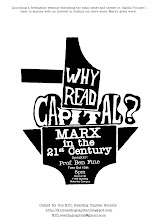For more than a hundred years introductory and accompanying literature to “Capital” has been produced. For as long as the work itself, the need has existed for comprehensible summaries, because the original text is extremely long and at times difficult to approach. In some places the book raises more questions than it answers and secondary literature can be helpful here. But we should be aware that every text accompanying “Capital” also has its own subjective interpretation and views the text from a certain angle.
The text can be read from a logical as well as from a historical point of view. It can be seen in the perspective of gender politics or interpreted with regard to law, etc. In addition there are many political traditions that each interpret Marx’s work in their own way (see below). This is how a lively debate about the “correct” interpretation of “Capital” has developed. As a beginner one can easily lose track of this jungle of debates and the hundreds of contributions made. And one should be careful not to have read more of the secondary literature than of the actual text. This way one can also avoid the danger of being too quickly taken up by any one particular way of reading “Capital”.
In the Reading Capital group we do not want to insist on one specific version. Since we are starting without preconditions the primary text by Marx is at the centre and should also be the point of reference in discussions.
The following table illustrates very basically the different (historical) schools of interpretation of Marx, or of the different “Marxisms”. The schematic subdivision follows a very rough and simplified pattern. The years are merely to give an approximate orientation – the actual transitions were much more fluid and the blocks represented here are by far not that homogenous. Who wants to have a look at the different “schools” of Marxism can find useful indications in Leszek Kolakowski’s three-volume work “Main Currents of Marxism”. Each of these different perspectives has produced texts accompanying “Capital”, each with specific nuances – which is why there can be no “objective” secondary literature.
What? / When? / Where? / Main focus
Traditional Marxism 1st Generation / from 1878 on / SPD, 2nd International, Engels, Kautsky, Bebel, Bernstein and others / development of history along laws of nature
Traditional Marxism, 2nd Generation / 1914 until early 1920’s / Early 3rd International, Luxemburg, Lenin, Trotsky, Bucharin / Revolutionary perspective, against Reformism of 2nd International
Trad. Communist Interpretation, Marxism-Leninism / after 1928 / Communist Parties after Stalinisation / Party as the centre of praxis and theory, Marxism as state- Doctrine (USSR)
Western Marxism, Reference to working class / from 1923 on / Korsch, Lukács, Gramsci / Subjectivity of revolutionary praxis
Western Marxism, Frankfurt School / from 1930 on / Adorno, Marcuse, Horkheimer / Mechanisms of integration of late Capitalism
Neue Marx-Lektüre / from 1968 on / Backhaus, Heinrich, Hirsch / Critique of forms of capitalist socialisation
The different schools of Marxism stimulate the vivid debates around the interpretation of “Capital”. But the reason for this struggle of interpretation is the work itself. In the following comments we want to exemplify the controversies amongst Marxists by highlighting some points which are the objects of those controversies.
The status of the dialectical method:
In “Capital” Marx does not explicitly state whether and to what extent his analysis uses Hegelian dialectics. How do we therefore have to interpret formulations which seem to follow Hegelian categories (such as form and content or appearance and being)? [FORM, INHALT, SCHEIN, SEIN] And if the dialectic is always implicitly present, how can we understand the work without philosophical knowledge at all?
Historical or logical account in chapter 1 of volume I:
Does the depiction of the development from simple exchange of commodities to the capitalist wage labour (respectively the development of money) follow an imagined, real historical course or does Marx use abstractions in order to identify the specifically capitalist basic forms [GRUNDFORMEN] of value, labour and capital?
There are also differences as to where and when value is developed. An approach which is sometimes referred to as “the substantiveness of value theory” [“werttheoretischer Substantialismus”] situates the creation of value already in production. Others hold the view that value is only created when commodities face each other as commodities, i.e. in the exchange-process.
Another important field of debate is gender relations. To what extent does the analysis of “Capital” consider the oppression of women? What is the relation between wage labour and reproductive labour (Reproduktionsarbeit) in the determination of the value of labour-power?
This is only a small selection of questions and controversies which have emerged from “Capital”. The most important questions, however, often develop in the reading groups themselves and they can be completely different from the ones outlined here. These illustrations do not aim at working along a pre-modelled catalogue of questions, they merely show that reading “Capital” can open up many exciting debates in reading groups.
Subscribe to:
Post Comments (Atom)

No comments:
Post a Comment